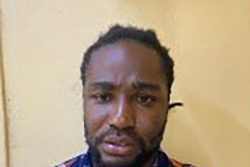Though there has been a noticeable increase in the number of narcotics busts within the last week, nothing is being said about the origin of the drugs or what is being done by the government and the relevant authorities to stem the flow.
Opposition leader Brigadier (rtd) David Granger while noting that the cocaine and marijuana which is being seized is just a small fraction of what is actually in the country, said that the government is to be blamed for its failure to effectively tackle the thriving local narco-trafficking operation especially since no steps have been taken to secure the country’s poorly manned borders.
Within the last week some 1217 kilograms of marijuana and in excess of 45 kilograms of cocaine have been seized by local narcotics officials – the Customs Anti-Narcotics Unit (CANU) and the Police Narcotics Unit. In relation to marijuana for this year several large fields where the plants were being grown were found and destroyed. It has always been said by security exports and observers that drugs enter across the porous borders that separate Guyana from Suriname, Venezuela and Brazil. Over the years drugs have been intercepted in Corentyne, Berbice, an area close to the border that we share with Suriname.
During a recent interview Granger told Stabroek News that the major problem with narco-trafficking in Guyana is the attitude of the administration. He said that the government has failed to implement a National Drug Strategy Master plan and provide the necessary assets to CANU and the police.
He said that the government lacks “political will in waging a serious war on narco-trafficking,” and that this is the real issue which allows narco-trafficking to thrive. Unless and until the government drafts a serious National Drug Strategy master plan and equips the law enforcement agencies so that they can go after narco-traffickers “we are going to have a recurring problem.”
According to the APNU leader the drugs fight comes all the way back to political will. He noted that the laws are there on the books but there is no architecture in place to ensure that the best information is provided in pursuit of the drug lords. “The problem lies entirely with the political administration,” he said, adding that the law enforcement agencies simply do not have the aircraft, the all-terrain vehicles, the boats and the personnel to go into the areas where the narcotics trafficking is taking place.
Granger said that every year the United States Department of State through its International Narcotics Control Strategy report (INCSR) points out that the narcotics are coming across the borders: “…but we are not providing the law enforcement agencies with the resources to patrol those borders, so we know that drugs are coming by the tons and we are only discovering these small amounts when people attempt to smuggle them; even though they are going in wood and various objects, these represent only a fraction of the narcotics coming into the country. Now our traffickers are bound up with the mafia and international drug trafficking cartels.”
He stated that it is known the cocaine is coming through the borders as it is not grown here in Guyana. He said that this will be an area which will be explored by the US Drug Enforcement Agency (DEA) once it has been established here. “It will be a contributory factor but we need a greater display of political will by the Government of Guyana if we are to make progress,” he said.
According to Granger the recent increased number of busts is not something to be ignored but “again what is being discovered in these so called busts is only a fraction of what is bound to be coming out. The busts are small relative to what we expect to be going out of the country. Nobody can tell [if it is just pure luck].”
He noted that one can use the number of execution-style murders and the number of busts made as indicators of the degree of drug trafficking. He said that anti-money laundering measures should indicate the amount of dirty money, but “no one can tell for sure and I would say on a scale it [drug trafficking here] is extremely serious.” He said that this trade is responsible not only for execution-style murders but also for contributing to gun-running. Granger stated that illegal guns are used to protect the illegal trade: “It is damaging the country. It is ruining lives and it is distorting the economy.”
Turning his attention to marijuana, Granger said that that situation is just as serious as the cocaine trafficking one, especially given the fact that it is being grown right here in Guyana.
Asked about what CANU had described as Jamaican marijuana which was discovered during an operation in Golden Grove, East Bank Demerara last Monday, Granger told this newspaper he cannot determine its source. He said that he is unsure it this is a type of ganja or whether it refers to the source country.
Stabroek News was unable to clarify this, but according to a security source there is a type of marijuana referred to as high grade which is grown in Jamaica. It was noted that this type of the drug is different to what is grown here as the processes for growing the two are very different. The source said that growing the high grade marijuana takes a lot of time and work; one simply cannot leave the plants unattended.
Granger also told this newspaper that Guyana produces a lot of its own marijuana and as such he will “be very surprised if they have to import marijuana from overseas because Guyana… exports marijuana.”
Lackadaisical approach
Meanwhile leader of the Alliance for Change Khemraj Ramjattan said that the government has been “lackadaisical” in its approach to narco-trafficking and is now seemingly trying to get its act together ahead of the arrival of the DEA.
“They now understand that they have to get their act together because the DEA is coming…” he said, adding that “they are tightening up as a result of now bringing in the DEA …That has had impact. It is my opinion. It is a good thing,” he said.
Asked if he agreed with suggestions that these busts came about as a result of pure luck, he responded, “Absolutely not. It is deliberate and they are now stretching that further mile to ensure that everybody as much as possible is caught.”
He added too that he is not surprised at the large quantities that are being intercepted during each bust. “I know that Guyana is a huge transshipment point and we are also now growers of marijuana in the backlands in huge acreages, and this was told a long time ago to me by the narcotics division, and the government wanted to deny that it was so much.”
Ramjattan added that “this government has an attitude that this narcotics trade is as a consequence of the demand that is in the Western world and so they feel that if the demand is there, let it go. We should be suppliers.”
He said too that the cocaine that enters Guyana probably originates from Colombia and those other countries that produce on a large scale. He said too that the drugs enter Guyana “obviously through airplane which are breaching our airspace and dropping it off in airstrips in the jungle or drop-off points and then it is collected and then distributed to these couriers. It is big business. Huge business in Guyana.”
According to Ramjattan, the DEA ought to have been here long ago, but “no late time is a bad time.” He added that it has “proven now that getting their act together is a good thing for this country because what cocaine also does it is a deformity in relation to a country’s real income. It gives the impression that we are a wealthy country because of all the fancy buildings going up and so on, but it is not money that is coming from the regular sector and to that extent I feel that the government condones it, but with the DEA coming here now they are going to bring that to a halt.”
According to Ramjattan the government is deliberately turning away their eyes from narco-trafficking probably because of the large amount of money it brings into the economy.
He said that the AFC has been saying repeatedly that the DEA should be here and that there must be more superior training for ranks and the availability of assets to help with surveillance at the borders. “The AFC felt that they are lapsing and very lackadaisical in their approaches and that is where the problems lie. If there is any further strengthening of any legislation that we can do we will definitely support it,” he said, before adding that anti-money laundering is an important aspect of the drug fight. He noted that his party will support it but only if the public procurement commission is set up.
A CANU operation in the Golden Grove/Diamond area unearthed approximately 1.2 tons of marijuana and 4.2 kilograms of cocaine last Monday. Dexter Daniels on Friday during his second court appearance pleaded guilty and was sentenced to three years in jail.
Days before that the police found 17 kilograms of cocaine stashed in ceramic ornaments as they were being prepared for shipment to Ireland. Two persons have since been charged in connection with this.
Several outgoing passengers at the Cheddi Jagan International Airport have also been charged for having various amounts of cocaine.
Last Friday, 4.5 kilograms of dried marijuana was among items police found in a camp located at Sheet Anchor, East Canje, Berbice. Two men who were at the camp, managed to escape.









